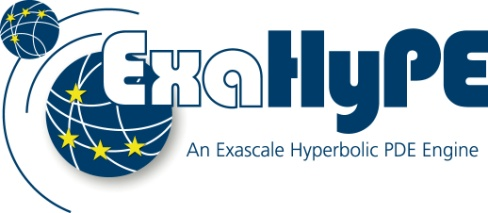ExaHyPE 2

www.exahype.org
ExaHyPE is an open source simulation engine to solve hyperbolic PDE systems. It is built on top of dynamically adaptive Cartesian meshes and offers support for Finite Volume, Runge-Kutta Discontinuous Galerkin and ADER-DG discretisations. ExaHyPE is written in a way that most computer science aspects as well as most of the numerics are hidden away from the user: Users plug in user functions for their PDE formulation (such as flux functions and eigenvalues) into the engine and then delegate all further work to ExaHyPE.
The original ExaHyPE project (and therefore code) received funding from the European Union’s Horizon 2020 research and innovation programme under grant agreement No 671698 (project ExaHyPE). After the project has successfully completed, we decided to completely rewrite, clean up and improve the code base. We decided to write ExaHyPE 2. ExaHyPE 2 is now completely integrated into its AMR baseline Peano 4 (which is a complete rewrite, too, where we also learned from the original ExaHyPE project), and it is shipped as part of this code/repository as a toolbox or extension. Download Peano and you get ExaHyPE 2. Peano’s guidebook documents how to use the engine, Peano’s license also holds for ExaHyPE 2, and Peano’s repository and Slack structure provide the infrastructure for ExaHyPE.
Funding
ExaHyPE today is one of ten pilot codes targeted by the ChEESE Centre of Excellence in Solid Earth funded via the European Union’s Horizon 2020 research and innovation programme under grant agreement No 823844. Its core development in the UK is heavily supported by the UK’s exascale programme ExCALIBUR, and further support is provided via smaller national grants in both Germany and the UK.
Please consult the project pages to the right for some examples for ongoing projects around ExaHyPE.
Legacy code base
ExaHyPE 2 continues to be is hosted at the gitlab of the Leibniz Supercomputing Centre. The official project website continues to be exahype.eu, while we make the URL exahype.org point to the new developments, i.e. this page. You find “historic” information about the first generation of ExaHyPE at the eu address. The git repository remains available for download, though very few people still improve the code base due to the rewrite and integration into Peano 4.
Description
For details on the engine, see our article ExaHyPE: An engine for parallel dynamically adaptive simulations of wave problems (Comp. Phys. Comm. 254, 2020).
If you prefer a more computer science-focused explanation of the rationale and design decisions behind ExaHyPE and ExaHyPE 2, which they inherit directly from their AMR code base Peano, please read the ACM TOMS paper (ACM TOMS 45 (2), 2019).

- Thanks to Gokberk Kabacaoglu's initiative, we now finally have our book impact section up: https://scicomp.webspace.durham.ac.uk/scicomp-contributes-to-three-new-springer-publications/ One of the books originates from our module Parallel Scientific Computing in level 3, one from @miscada.bsky.social's professional skills module, and one from AI.
- We finally got our SIAM CSE wrap-up page up: https://scicomp.webspace.durham.ac.uk/news-announcements/ Not only staff, but also PhD and @miscada.bsky.social students!
- Our Gregynog Numerical Relativity 2025 workshop is now announced and open for registration: https://sites.google.com/view/nrgregynog/
- Great group "day out" discussion on the pros and cons of wfh vs in-office wrt our code development. Two questions remain: (a) will we be able to implement our ideas and (b) where can we summarise and find best practices from other groups in scientific computing?
- Looking forward to participate in the Coimbra Group Climate Symposium today at @durham-university.bsky.social's new business school building at the water front. In line with that, my read of the day: arxiv.org/pdf/2503.17283 https://arxiv.org/pdf/2503.17283